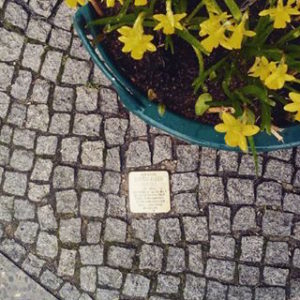
Rome: The Good, the Bad, the Heartbreaking.
The Heartbreaking
Look down.
I know I’ve insisted on looking up. Having your breath taken away by the extreme beauty of Italian ceilings is an experience that never gets old.
But one day I happened to look down as I opened the front doors of my apartment on Via Germanico, 96. I saw three brass squares the size of cobblestones, set slightly askew in the sidewalk. 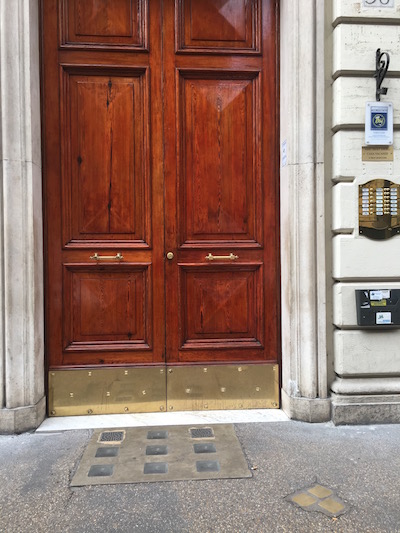
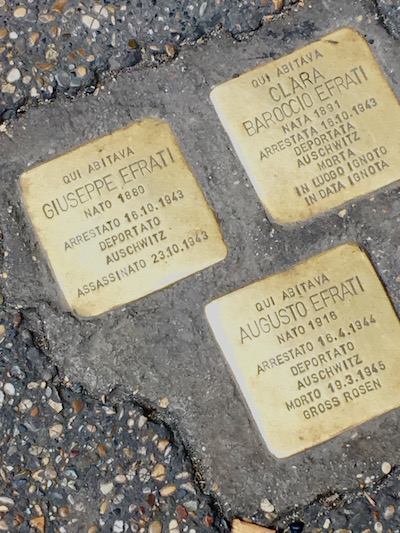 Curious, I looked closer. A few minutes later, I felt my heart crack. A teaspoon of information was on each one; a name, three dates, two places.
Curious, I looked closer. A few minutes later, I felt my heart crack. A teaspoon of information was on each one; a name, three dates, two places.
Qui Abitava
Giuseppe Efrati
Nato 1880
Arrestato 16.10.1943
Deportato
Auschwitz
Assassinato 23.10.1943
I can only recognize a few words in Italian, but I understood this immediately. Arrested, deported, assassinated. I barely needed the dates to know what I was looking at. Auschwitz is synonymous with Hell in every language. In one blink, I’d seen a Holocaust memorial, powerful and painful. Here, right here, these people lived, just as I lived here now, and they were taken from here to be slaughtered.
Qui Abitava
Clara Baroccio Efrati
Nata 1891
Arrestata 18.10.1943
Deportata
Auschwitz
Morta
in luogo ignoto
in data ignoto
I had to Google Translate the ending of Clara Baroccio Efrati’s brass square
Dead
In an unknown place
On an unknown date
The third square belonged to their son.
Qui Abitava
Augusto Efrati
Nata 1916
Arrestata 16.4.1944
Deportata
Auschwitz
Morta 19.3.1945
Gross rosen
It ended with another phrase I didn’t understand; Gross rosen. Big Roses? What could that mean? Google knew. It was the center of an industrial complex and the administrative hub of a network of at least 97 subcamps. If you saw the movie Schindler’s List, it was set there.
What did the writing on the three brass squares tell me? A 63-year-old man and 52-year-old woman – husband and wife (most likely) and their 29-year-old son, who shared the name of an emperor of Rome. The couple was arrested in October 43, he first, she two days later. The young man was not captured until April 44, seven months later. I wonder, was he in hiding, or in denial? Unable to escape or unwilling to leave his home? The father died a week after deportation, the mother’s death is at a place and at a date unknown. The son survived for 11 months after his arrest.
I don’t know which fragment of information is more devasting. The two days the wife is left behind, or the day they knock at the door again? The mother’s anonymous death and unmarked grave, or the seven months the son spent in grief and dread? Auschwitz was liberated by the Soviets Jan 27, 1945 but not soon enough for the son. He dies two months after that date, after eight months of forced slavery and unspeakable misery, exterminated by the Nazi regime.
I began to see these brass plaques in memoriams in front of doors in other Roman streets. 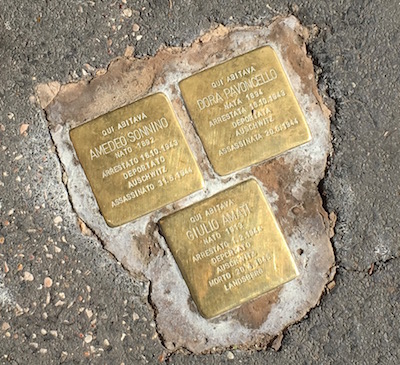 They never failed to crack my heart wide open.
They never failed to crack my heart wide open.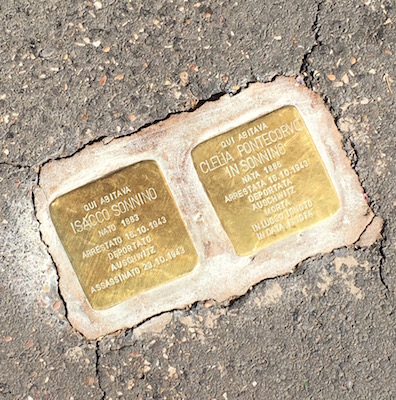 They commemorated Jews and patriots. The memorial for Don Pietro Pappagallo was a Resistance priest killed in the Fosse Ardeatine massacre in 1944 and whose character featured in Rossellini’s movie Open City
They commemorated Jews and patriots. The memorial for Don Pietro Pappagallo was a Resistance priest killed in the Fosse Ardeatine massacre in 1944 and whose character featured in Rossellini’s movie Open City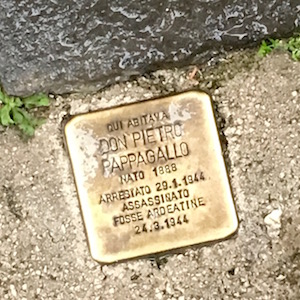
I learned more about the origins of these miniature memorials, called stolpersteins, via Google, Wikipedia and NPR.
“The stolperstein art project was initiated by the German artist Gunter Demnig in 1992, and is still ongoing. It aims at commemorating individual persons at exactly the last place of residency—or, sometimes, work—which was freely chosen by the person before he or she fell victim to Nazi terror, euthanasia, eugenics, was deported to a concentration or extermination, or escaped persecution by emigration or suicide. As of 31 January 2017, over 56,000 stolperstein have been laid in 22 European countries, making the stolperstein project the world’s largest decentralized memorial.”
Virginia- we were recently visiting Rome and stayed in a place in your building. We too had our hearts cracked open when we saw those brass markers. I, too, wondered in what apartment they lived. I live in Jerusalem so hope to get to Yad Vashem and search their names and see if there is additional info about them.
I was just telling a friend about this. The memorials, so visually humble, had compelling emotional power. The artist who created the project restored a little of my faith in humanity. May those souls always be remembered.
Safe travels home.